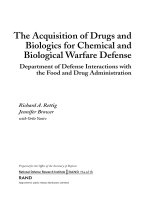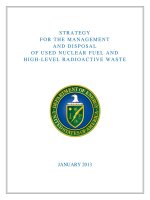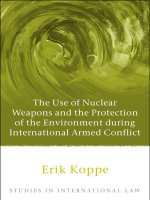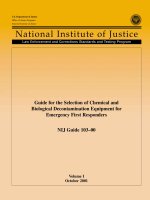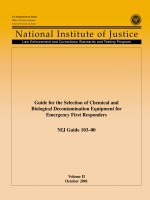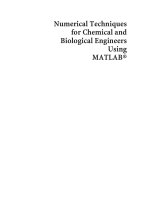nuclear, chemical, and biological terrorism
Bạn đang xem bản rút gọn của tài liệu. Xem và tải ngay bản đầy đủ của tài liệu tại đây (2.33 MB, 185 trang )
LEWIS PUBLISHERS
A CRC Press Company
Boca Raton London New York Washington, D.C.
Emergency
Response
and
Public Protection
Mark E. Byrnes
David A. King
Philip M. Tierno, Jr.
and
Nuclear, Chemical,
Biological Terrorism
This book contains information obtained from authentic and highly regarded sources. Reprinted material
is quoted with permission, and sources are indicated. A wide variety of references are listed. Reasonable
efforts have been made to publish reliable data and information, but the author and the publisher cannot
assume responsibility for the validity of all materials or for the consequences of their use.
Neither this book nor any part may be reproduced or transmitted in any form or by any means, electronic
or mechanical, including photocopying, microfilming, and recording, or by any information storage or
retrieval system, without prior permission in writing from the publisher.
The consent of CRC Press LLC does not extend to copying for general distribution, for promotion, for
creating new works, or for resale. Specific permission must be obtained in writing from CRC Press LLC
for such copying.
Direct all inquiries to CRC Press LLC, 2000 N.W. Corporate Blvd., Boca Raton, Florida 33431.
Trademark Notice: Product or corporate names may be trademarks or registered trademarks, and are
used only for identification and explanation, without intent to infringe.
Visit the CRC Press Web site at www.crcpress.com
© 2003 by CRC Press LLC
Lewis Publishers is an imprint of CRC Press LLC
No claim to original U.S. Government works
International Standard Book Number 1-56670-651-3
Printed in the United States of America 1 2 3 4 5 6 7 8 9 0
Printed on acid-free paper
Library of Congress Cataloging-in-Publication Data
Catalog record is available from the Library of Congress
Foreword
The authors of this excellent book provide a concise but comprehensive review of
various types of weapons of mass destruction, along with sound advice and simple
actions that can be taken by emergency responders and the general public to reduce
risks and avoid panic in the event of a terrorist attack. By simply reading through
this book, emergency responders and the public will learn what they can do to
minimize danger to health and life after an attack. The most important actions are
summarized at the end of the book. This summary becomes a convenient checklist.
Through my own personal experiences facing high intensities of radiation and
radioactive materials, managing patients who have been exposed to intakes of radio-
active material, and training and discussing concepts and actions with emergency
responders and the public, I’ve found that people want to do the right thing when
faced with dangerous situations. In the event of a terrorist attack, they want to
respond by protecting health and saving life. This book helps them do that.
I recommend that emergency responders and persons establishing homeland
security programs read this book, along with every person who wants to conserve
health and save life. The more people that know the material in this book, the less
will be the panic and loss of life in the terror that follows a weapon of mass
destruction attack. There are other books on this subject that are less complete and
largely out-of-date. This book is comprehensive, up-to-date, and provides sound
advice for protection in the event of a terrorist attack involving weapons of mass
destruction.
Allen Brodsky, Sc.D., CHP, CIH, DABR
Adjunct Professor of Radiation Science
Georgetown University Chair
Ad Hoc Committee on Homeland Security
Health Physics Society
© 2003 by CRC Press LLC
© 2003 by CRC Press LLC
Preface
Following the events of September 11, 2001, the United States began a strategic
assault against terrorist groups around the world with the objective of ridding the
world of large terrorist organizations that could potentially repeat a September 11
type event. As an added level of security, President George W. Bush established a
new Department of Homeland Security that has the responsibility for reducing
America’s vulnerability to terrorism. While both actions represent good first steps
in helping rid the world of terrorism, the American public has been forced to come
to grips with the reality that the nation faces a strong possibility of future large-
scale terrorist events occurring within its borders. The American public has also
come to realize that it must play a critical role in helping prevent these types of events.
While everyone can gain valuable information from this book on how to protect
themselves from terrorist activities involving nuclear, chemical, and biological weap-
ons, its target audiences are emergency response personnel, safety professionals, law
enforcement officials, and Federal Bureau of Investigation agents (all referred to as
emergency responders) because they are likely to receive first-hand exposure to one
or more terrorist events involving these types of weapons. The primary objectives
of this book are to provide emergency responders with guidance on:
• Weapons of mass destruction that could be used in a terrorist attack
• Mechanisms by which terrorists could disperse various types of nuclear,
chemical, and biological agents
• Conventional explosives that terrorists could use to disperse these agents
• Routes by which individuals are exposed to these agents
• Health hazards that may result from exposure to these agents
• Techniques by which safety professionals can minimize exposure to these
agents
• Potential medical treatment options for those exposed to these agents
• Methods to increase chances of surviving a nuclear explosion
• Emergency preparedness measures for a variety of settings
• Techniques for prioritizing injuries
• Personnel decontamination methods to be administered prior to medical
treatment
• Radiation exposure guidelines
• Training guidelines
It is the authors’ intent that the information in this book will help reduce exposure
of emergency responders to these types of agents, and as a result, help save lives.
© 2003 by CRC Press LLC
Authors
Mark E. Byrnes, P.G. is a senior scientist at the
U.S. Department of Energy’s Hanford Nuclear Res-
ervation in Richland, Washington. Byrnes works for
Fluor Hanford and has 18 years of experience per-
forming and designing environmental investigations
in radioactive and chemical (including warfare
agent) environments. He earned a B.A. in geology
from the University of Colorado at Boulder and an
M.S. in geology and geochemistry from Portland
State University in Oregon. Byrnes is an adjunct
professor at Washington State University's Tri-Cities
Campus and is a registered professional geologist in
the states of Washington, Tennessee, and Kentucky. He is the author of two textbooks
used at major universities: Sampling and Surveying Radiological Environments and
Field Sampling Methods for Remedial Investigations, published by CRC Press and
Lewis Publishers in 2001 and 1994, respectively.
David A. King, C.H.P. is a certified health physicist
working for Science Applications International Cor-
poration in Oak Ridge, Tennessee. King earned a
B.S. in physics from Middle Tennessee State Uni-
versity (1991) and an M.S. in radiation protection
engineering from the University of Tennessee at
Knoxville (1993). He received certification from the
American Board of Health Physics in 1999 (recer-
tified in 2003) and is a member of the Health Physics
Society and the Society for Risk Analysis. King’s
primary responsibilities include managing environ-
mental studies for radiologically contaminated sites,
designing characterization plans and interpreting associated data, preparing CER-
CLA documentation, and conducting human health risk and dose assessments. Major
clients include the U.S. Department of Energy on the Oak Ridge Reservation (Oak
Ridge, Tennessee) and in Paducah, Kentucky and the U.S. Army Corps of Engineers
through the Formerly Utilized Sites Remedial Action Program (FUSRAP).
© 2003 by CRC Press LLC
Philip M. Tierno, Jr., Ph.D. is a well known micro-
biologist with more than 30 years of experience in
the fields of clinical and medical microbiology. He
is the director of clinical microbiology and diagnos-
tic immunology at Tisch Hospital, New York Uni-
versity Medical Center, as well as Mt. Sinai Medical
Center, and is a part-time associate professor at the
New York University School of Medicine. He per-
formed his graduate studies at New York University,
where he was awarded an M.S. in 1974 and a Ph.D.
in 1977. Dr. Tierno acts as a consultant to the office
of the attorney general of New York State, the
Department of Health of the City of New York, the National Institutes of Health in
Bethesda, Maryland, and the College of American Pathologists. Dr. Tierno is a
member of the New York City Mayor’s Task Force on Bioterrorism. Technical
articles written by Dr. Tierno have appeared in the American Journal of Public
Health, Journal of Clinical Microbiology, American Journal of Clinical Pathology,
Reviews of Infectious Diseases, Journal of Infectious Diseases, and other publica-
tions. In the past 10 years, he has also authored several books including Staying
Healthy in a Risky Environment (Simon & Shuster), The Secret Life of Germs:
Observations and Lessons from a Microbe Hunter (Pocket Books), and Protect
Yourself against Bio-terriorism (Pocket Books).
© 2003 by CRC Press LLC
Acknowledgments
The authors would like to recognize Richard Wilde, P.K. Brockman, and Donald
Moak (Duratek Federal Services) for providing funding to support the editing of
this book as well as technical resources with expertise in the areas of explosives and
explosives transportation.
We would also like to recognize Kenny Flemingh (C.H.P.), Allen Brodsky
(C.H.P.), and Theresa Patterson (P.M.P.) from Science Applications International
Corporation; Richard Toohey (C.H.P.) of the Oak Ridge Institute for Science and
Education; Phillip Amundson (C.I.H., C.S.P.), Manager of Safety and Emergency
Preparedness for Tacoma School District 10; Bruce Cannard (Principal, Canyon
View Elementary School); and Rose Ruther for performing technical reviews on
multiple sections of this book and providing technical expertise in the areas of
radiation health physics, radiation safety, safety engineering, and industrial hygiene.
Microecologies, Inc. should also be recognized for financial and technical contribu-
tions in the area of industrial hygiene.
The authors would like to express their appreciation for all the support provided
by their families, particularly Karen Byrnes, Christine Byrnes, Kathleen Byrnes,
Frieda Byrnes, and Shelley King, Josephine Tierno, Alexandra and Francois Payard,
and Meredith and Thomas Mallon.
© 2003 by CRC Press LLC
Contributors
Grant M. Ceffalo, C.H.P. is the manager of the Radiological Control Department
for Bechtel Hanford, Inc. at Richland, Washington. Ceffalo has worked in the fields
of radiation monitoring instrumentation, dosimetry, environmental measurement and
release, as well as training. He earned a B.S. in radiation science from the University
of Washington and an M.S. in radiological science from Colorado State University.
Ceffalo is a comprehensively certified health physicist and a member of the American
Academy of Health Physics.
Sheldon R. Coleman, C.I.H., P.E. is the industrial hygiene program administrator
for Bechtel Hanford, Inc. at the Department of Energy’s Hanford site at Richland,
Washington. He has extensive experience in respiratory protection, chemical hazard
evaluation, and the design of engineering controls. He also has 10 years of experience
with the U.S. Air Force in the fields of nuclear, biological, and chemical warfare.
Coleman earned a B.S. in chemical engineering from the University of Washington,
attended the U.S. Air Force School of Aerospace Medicine, and earned a master’s
degree in public administration from the University of Oklahoma. He is certified in
the comprehensive practice of industrial hygiene and registered as a professional
engineer.
William M. Sothern is an industrial hygienist and chief investigator for Micro-
ecologies, Inc., a New York City-based firm that conducts environmental investiga-
tions and performs environmental cleanup contracting. Sothern holds a master’s
degree in environmental and occupational health from Hunter College in New York
and is a member of the American Industrial Hygiene Association and the American
Conference of Government Industrial Hygienists. He has been involved closely with
the air monitoring and cleanup efforts in the downtown New York area in the
aftermath of the World Trade Center disaster and is currently working with New
York City companies and residents to develop emergency preparedness plans for
possible future terrorist attacks.
Richard P. Genoni is a principal engineer with Duratek Federal Services’Northwest
Operations in Richland, Washington. Genoni maintains the Explosive Classification
Tracking System for the Department of Energy’s National Transportation Program
and reviews all new explosive applications before submittal to the Department of
Transportation. He also maintains Department of Energy Interim Hazard Classifi-
cations in accordance with the Department of Defense Ammunition and Hazard
Classification Procedures, TB 700–2.
© 2003 by CRC Press LLC
Diane Forsyth is a technical editor at Duratek Federal Services’ Northwest Oper-
ations in Richland, Washington. In addition to performing the primary editing of
this book, she has authored and edited numerous articles, newsletters, books, and
other printed resources. She earned a B.A. from Walla Walla College, Washington,
and an M.A. from Andrews University, Berrian Springs, Michigan. She has also
done extensive doctoral work at schools in California and Washington, D.C.
Scott D. Elliott is manager of the Waste and Transportation Services Department
for Duratek Federal Services at the Hanford Nuclear Reservation, Richland, Wash-
ington. Elliott has worked in the fields of nuclear operations, training, and waste
treatment for 24 years and has additional experience as a nuclear facility building
emergency director. He is presently a nuclear, biological, and chemical operations
instructor for the U.S. Army Reserves.
© 2003 by CRC Press LLC
Contents
Dedication
Abbreviations and Acronym
Glossary
Chapter 1 Introduction
1.1 Purpose and Scope
1.2 Historical Perspective on Terrorism Targeted against the U.S.
1.3 Historical Development of Nuclear Weapons
1.3.1 The Race to Develop the First Nuclear Weapon
1.3.2 Modern Nuclear Weapons
1.3.3 Modern Weapons Using Depleted-Uranium Projectiles
1.3.4 Other Potential Terrorist Uses for Radioactive Materials
1.4 Historical Development of Chemical Weapons
1.4.1 Geneva Protocol
1.4.2 A New Age of Chemical Weapons Development
1.4.3 Prohibition of Development, Production, and Stockpiling
of Biologic and Toxic Weapons
1.4.4 Weaponization and Delivery of Chemical Agents
1.5 Historical Development of Biological Weapons
1.5.1 Modern Biological Weapons
1.5.2 Current Genetic and Molecular Engineering
1.5.3 Post-September 11 Anthrax Attacks
1.5.4 Agroterrorism
1.6 Conventional Explosives Available for Dispersing Agents
1.6.1 Primary Explosives
1.6.1.1 Lead Azide
1.6.1.2 Silver Azide
1.6.1.3 Tetrazene
1.6.1.4 Lead Styphnate
1.6.1.5 Mercury Fulminate
1.6.1.6 Diazodinitrophenol
1.6.2 Secondary Explosives
1.6.2.1 Trinitrotoluene (TNT)
1.6.2.2 Tetryl
1.6.2.3 Picric Acid
1.6.2.4 Nitrocellulose
1.6.2.5 Nitroglycerine
1.6.2.6 Nitroguanidine
1.6.2.7 Cyclotrimethylenetrinitramine (RDX)
© 2003 by CRC Press LLC
1.6.2.8 Cyclotetramethylenetetranitramine (Octogen or HMX)
1.6.2.9 1,3,5-triamino-2,4,6-trinitrobenzene (TATB)
1.6.2.10 Pentaerythritol Tetranitrate (PETN)
1.6.2.11 Hexanitrostilbene (HNS)
1.6.3 Propellants
1.6.3.1 Gun Propellants
1.6.3.2 Rocket Propellants
1.6.4 Pyrotechnics
1.6.5 Other Compounds Used in Explosives
1.6.6 Initiation Techniques
1.6.7 Analytical Methods for Testing for Explosives
1.6.8 Triggering Mechanisms for Explosive Devices
References
Chapter 2 General Types of Radiation and Warfare Agents
2.1 Radiation
2.1.1 External Radiation
2.1.1.1 Gamma Particles
2.1.1.2 Beta Particles
2.1.1.3 Alpha Particles
2.1.2 Internal Radiation
2.1.3 Radiation Source Material
2.1.3.1 Potential Source Materials
2.1.3.2 Black Market Activities involving Radiological
Materials
2.2 Chemical Warfare Agents
2.3 Biological Warfare Agents
References
Chapter 3 General Hazards from Exposure to Radiation and Warfare Agents
3.1 Radiation
3.1.1 Radiation Damage in Human Tissue
3.1.2 Chronic Radiation Exposures
3.1.3 Acute Radiation Exposures
3.2 Chemical Agents
3.2.1 Blister Agents
3.2.1.1 Mustards
3.2.1.2 Arsenicals
3.2.1.3 Nitrogen Mustards
3.2.1.4 Oximes
3.2.1.5 Mixes
3.2.2 Blood Agents
3.2.2.1 Hydrogen Cyanide (AC)
3.2.2.2 Cyanogen Chloride (CK)
© 2003 by CRC Press LLC
3.2.2.3 Arsine (SA)
3.2.3 Choking Agents
3.2.3.1 Chlorine
3.2.3.2 Phosgene (CG)
3.2.3.3 Diphosgene (DP)
3.2.4 Nerve Agents
3.2.4.1 Tabun (GA)
3.2.4.2 Sarin (GB)
3.2.4.3 Soman (GD)
3.2.4.4 V-Gas (VX)
3.3 Biological Agents
3.3.1 Bacterial Agents
3.3.1.1 Bacillus anthracis (Anthrax)
3.3.1.2 Yersinia pestis (Plague)
3.3.1.3 Brucella melitensis (Brucellosis)
3.3.1.4 Francisella tularensis (Tularemia)
3.3.1.5 Coxiella burnetii (Q Fever)
3.3.1.6 Vibrio cholerae (Cholera)
3.3.1.7 Burkholdera mallei (Glanders)
3.3.1.8 Burkholdera pseudomallei (Melioidosis)
3.3.2 Viral Agents
3.3.2.1 Variola Major (Smallpox)
3.3.2.2 Venezuelan Equine Encephalitis
3.3.2.3 Crimean Congo Hemorrhagic Fever
3.3.2.4 Rift Valley Hemorrhagic Fever
3.3.3 Toxins
3.3.3.1 Clostridium botulinum toxin
3.3.3.2 Clostridium perfringens toxin
3.3.3.3 Staphylococcus Enterotoxin B
3.3.3.4 Ricin
3.3.3.5 Saxitoxins
3.3.3.6 Trichothecene Mycotoxins (T-2)
References
Chapter 4 Minimizing Exposure to Radiation and Warfare Agents
4.1 Time of Exposure
4.2 Distance
4.3 Shielding
4.4 Summary
Chapter 5 Responding to a Nuclear Explosion
5.1 Nuclear Explosion Basics
5.1.1 General Discussion
5.1.1.1 Radius of Complete Destruction
© 2003 by CRC Press LLC
5.1.1.2 Air Blast
5.1.1.3 Thermal Burns
5.1.1.4 Initial Radiation
5.1.1.5 Fallout
5.1.1.6 Combined Effects
5.2 Response to Nuclear Explosion
5.2.1 Time of Exposure
5.2.2 Shielding
5.2.3 Distance
5.3 Summary
References
Chapter 6 Preparing for a Nuclear, Chemical, or Biological Attack
6.1 Emergency Preparedness Plan
6.2 Emergency Preparedness Training
6.3 Emergency Preparedness Practice Drills
6.4 Alarm Systems
6.5 Air Purification Systems
6.6 Water Purification Systems
6.7 Personal Protective Equipment
6.8 First Aid Kits
6.9 Communication Devices
6.10 Emergency Lighting
6.11 Emergency Food Supplies
6.12 Screening Instruments
6.13 Summary
References
Chapter 7 Guidance for Emergency Responders
7.1 Prioritizing Injuries
7.2 Assessing Patients for Contamination
7.3 Personnel Decontamination Procedures
7.3.1 Radiation Decontamination Procedure
7.3.2 Chemical Agent Decontamination Method I
7.3.3 Chemical Agent Decontamination Method II
7.4 Exposure Guidance for Emergency Responders
7.5 Training For Emergency Responders
References
Chapter 8 Summary of Recommendations
8.1 Minimizing Exposure to Radiation (Dirty Bomb) and Warfare Agents
8.2 Minimizing Exposure to Radiation from Nuclear Explosion
8.3 Preparing for a Nuclear, Chemical, or Biological Attack
© 2003 by CRC Press LLC
8.3.1 Emergency Preparedness
8.3.2 Alarm Systems
8.3.3 Air Purification Systems
8.3.4 Water Purification Systems
8.3.5 Personal Protective Equipment
8.3.6 First Aid Kits
8.3.7 Communication Devices
8.3.8 Emergency Lighting
8.3.9 Emergency Food Supplies
8.3.10 Screening Instruments
8.4 Guidance for Emergency Responders
Bibliography
© 2003 by CRC Press LLC
Dedication
This book is dedicated to the emergency responders who lost
their lives in the September 11, 2001 terrorist attack,
as well as their families.
It is also dedicated to my father, Francis J. Byrnes, who
taught me to enjoy and appreciate the fields of science and
engineering, and provided me with guidance and
encouragement throughout my professional career.
MEB
© 2003 by CRC Press LLC
Abbreviations and Acronyms
AC Hydrogen cyanide (blood agent)
ALARA As low as reasonably achievable
BAL British Anti-Lewisite
CIA Central Intelligence Organization
CK Cyanogen chloride (blood agent)
CX Phosgene oxime
DFSH Duratek Federal Services Hanford
DFSNW Duratek Federal Services Northwest
DNA Deoxyribonucleic acid
DNT Dinitotoluene
ECD Electron capture detector
ED Ethyldichloroarsine (arsenical blister agent)
EGDN Ethylene glycol dinitrate
FH Fluor Hanford
FID Flame ionization detector
g Gram
GA Tabun (nerve agent)
GB Sarin (nerve agent)
GC Gas chromatography
GD Soman (nerve agent)
HAZMAT Hazardous materials
HD Distilled mustard
HEPA High efficiency particulate arrestor
HL Mustard–lewisite mixture
HMX Cyclotetramethylenetetranitramine
HN-1 2,2-Dichlorotriethylamine (nitrogen mustard agent 1)
HN-2 2,2-Dichloro-N-methyldiethylamine (nitrogen mustard agent 2)
HN-3 2,2,2-Trichlorotriethylamine (nitrogen mustard agent 3)
HNS Hexanitrostilbene
HPLC High-performance liquid chromatography
HT Distilled mustard combined with bis(2-chloroethyl sulfide) monoxide
IDLH Immediately dangerous to life or health
kg Kilogram
L Lewisite (arsenical blister agent)
lb Pound
LMNR Lead mononitoresorcinate
LNT Linear no threshold
KDNBF Potassium dinitrobenzofurozan
KGB Komitet Gosudarstvennio Bezopaznosti
© 2003 by CRC Press LLC
MD Methyldichloroarsine (arsenical blister agent)
NATO North Atlantic Treaty Organization
PD Phenyldichloroarsine (arsenical blister agent)
PETN Pentaerythritol tetranitrate
PBX Polymer-bonded explosive
ppm Part per million
rem Roentgen equivalent in man
RDX Cyclotrimethylenetrinitramine
SA Arsine (blood agent)
SAIC Science Applications International Corporation
SFC Supercritical fluid chromatography
T bis(2-chloroethyl sulfide) monoxide
TATB 1,3,5-Triamino-2,4,6-trinitrobenzene
TEA Thermal energy analyzer
TLC Thin layer chromatography
TNT Trinitrotoluene
U.S. United States
U.S.S.R Union of Soviet Socialist Republics
UV Ultraviolet
VX V gas (nerve agent)
© 2003 by CRC Press LLC
Glossary
Absorbed dose Energy imparted to matter by ionizing radiation per unit mass
of irradiated material at the place of interest in that material; expressed
in rad units.
Agroterrorism Form of terrorism that focuses on poisoning food supplies.
Alpha particle Positively charged (+2) radiation particle identical to the nucleus
of a helium atom that consists of two protons and two neutrons.
al-Qaida Worldwide terrorist network associated with Osama bin Ladin.
Anthrax Bacterial agent that may cause inhalation anthrax, cutaneous anthrax,
or gastrointestinal anthrax disease.
Atomic mass Number equal to the number of protons plus the number of neu-
trons present in the nucleus of an atom.
Atomic number Experimentally determined number characteristic of an ele-
ment that is equal to the number of protons in the nucleus.
Beta particle Radiation in the form of an energetic electron emitted from the
nucleus of an atom. Negatively charged (–1) radiation particle consisting
of an energetic electron emitted from the nucleus of an atom.
Biological agent Bacteria, virus, or toxin designed for use as a weapon.
Blistering agent Agent that affects the eyes and lungs and blisters the skin; the
five categories of blistering agents are mustards, arsenicals, nitrogen mus-
tards, oximes, and mixes.
Blood agent Agent absorbed into the body primarily through breathing; affects
the body by preventing normal utilization of oxygen by cells, which causes
rapid damage to body tissue. The most common blood agents include
hydrogen cyanide (AC), cyanogen chloride (CK), and arsine (SA).
Botulism Toxin that occurs in the form of food-borne botulism, wound botulism,
and infant botulism; one of the most toxic substances known to man.
Brucellosis Disease caused by Brucella melitensis, B. suis, B. abortus, or B.
canis bacteria species.
Chemical agent Chemical designed for use as a weapon; primary types include
blister agents, blood agents, choking agents, and nerve agents.
Choking agents Chemical agents designed to target the respiratory tract; they
cause lungs to fill with liquid, and death results from dry land drowning.
The primary agents include chlorine, phosgene, and diphosgene.
Cholera Toxin that causes the mucosal cells of the small intestine to hypersecrete
water and electrolytes into the lumen of the gastrointestinal tract.
Clostridium perfringens Pathogenic bacterium that causes toxin-mediated pul-
monary syndrome.
Combustion Self-sustained, exothermic, rapid oxidation reaction of explosive
substance and propellant.
© 2003 by CRC Press LLC
Conventional explosive Explosive other than a nuclear weapon. Examples
include nitroglycerine, picric acid, TNT, PETN, RDX, HMX, and TATB.
Copious Abundant, plentiful, present in large quantity.
Decontamination Removal of contamination from personnel or objects.
Deflagrating explosive A substance (e.g., propellant) that reacts by deflagration
rather than detonation when ignited and used in a normal manner.
Deflagration Chemical reaction in which the output of heat is sufficient to enable
the reaction to proceed and be accelerated without heat from another
source; a surface phenomenon in which reaction products flow away from
the unreacted material along the surface at subsonic velocity. The result
of a true deflagration under confinement is an explosion.
Depleted uranium Uranium composed predominantly of the U-238 isotope;
considered “depleted” because most of the U-235 component has been
removed.
Detonating explosive Substance that reacts by detonation rather than deflagra-
tion when initiated and used in a normal manner.
Detonation Most violent type of explosive event; supersonic decomposition
reaction that propagates through energetic material to produce an intense
shock in the surrounding medium (air or water) and rapid plastic defor-
mation.
Detonator Device for initiating an explosive that requires a shock wave. Initia-
tion may be via electrical means, friction, flash from another igniferous
element, stabbing, or percussion. A detonator may be constructed to
detonate instantaneously or may contain a delay element.
Dirty bomb A conventional explosive device also containing radioactive mate-
rials used for the express purpose of contaminating property and/or ter-
rorizing the general public.
Emergency responder Safety professional (fireman, police officer, medical
technician, etc.) who will respond to a terrorist attack involving nuclear,
chemical, or biological weapons.
Explosive train Arrangement of explosive components in which the initial force
from the primer is transmitted and intensified until it reaches and sets off
the main explosive composition.
Exposure Contact with ionizing radiation or radioactive material.
External dose Portion of dose equivalent received from radiation sources outside
the body.
Fallout Radioactive material that falls back to earth after a nuclear explosion.
Contains highly radioactive materials from the original weapon, vaporized
material from ground zero, and other materials pulled into the mushroom
cloud. The amount of fallout and spread of radioactivity depends on
weapon yield and meteorological conditions.
Gamma particle Energetic photon (particle of light) originating from the
nucleus of an atom produced when a neutron or proton drops from a high
energy level to a lower energy level.
Glanders Disease that mainly affects horses, but can be fatal in man.
© 2003 by CRC Press LLC
Gray (Gy) SI unit of absorbed dose; equal to an absorbed dose of 1 joule/kilo-
gram (100 rads).
Ground zero Location of a nuclear explosion. Exact location may be in the air
(using a bomb or missile) or underground but is assumed in this text to
be detonated on the ground, where it will do the most damage.
Half-life Time required for half of a radioactive substance to disintegrate by
radioactive decay.
Hemorrhagic fevers Ebola virus, Marburg virus, Lassa fever, Argentine and
Bolivian hemorrhagic fevers, Crimean Congo hemorrhagic fever, Rift
Valley fever, dengue hemorrhagic fever, and yellow fever.
High radiation area Accessible area where radiation levels could allow an indi-
vidual to receive a dose equivalent in excess of 0.1 rem (1 mSv) in 1 hour
at 30 centimeters from the radiation source or from any surface the
radiation penetrates.
Highly enriched uranium Uranium comprised of >20% U-235.
Igniter Small device loaded with an explosive that will deflagrate; the output is
primarily heat (flash), sometimes referred to as a squib.
Ignition Reaction occurring when a combustible material such as an explosive
is heated to or above its ignition temperature.
Ignition means Method employed to ignite a deflagration train of explosions of
pyrotechnic substances (e.g., a primer for propelling a charge, an igniter
for a rocket motor, or an igniting fuse).
Ignition temperature Minimum temperature required for the process of initia-
tion to be self-sustained.
Ingestion Process of taking material into the body via the digestive tract.
Inhalation Drawing air into the lungs through the nose and mouth.
Initiating device Another term for primary explosive.
Initiation Bringing an explosive to the state of deflagration or detonation.
Internal dose Portion of the dose equivalent received from radioactive material
taken into the body.
Islamic Jihad Shiite organization derived from the Amal movement; acts
through a number of subsidiary groups engaged in terrorism; Hizballah
and the Islamic Amal are its most successful branches.
Isotope Any of two or more species of atoms of a chemical element with the
same atomic number and different atomic mass. For example, U-238 and
U-235 are both isotopes of uranium.
Lethal Capable of causing death.
LC
50
Agent concentration in air that will kill 50% of those exposed through
inhalation.
LD
50
Amount of liquid or solid material that will kill 50% of those exposed
through skin absorption or ingestion.
Melioidosis Bacterial disease of rodents that can be transmitted to humans via
food contaminated by rodent droppings or biting flies.
mrem Millirem; one-thousandth of a rem. See rem.
Mushroom cloud Giant mushroom-shaped cloud extending from ground zero
well into the atmosphere; initially contains an immense fireball and highly
© 2003 by CRC Press LLC
radioactive materials that eventually fall back to earth at various distances
from ground zero.
Nerve agent Chemical agent inhaled, absorbed through the skin, or ingested that
causes interference with the neural synapses and overstimulation of the
nervous system, which in turn leads to overreactivity in the muscles and
malfunctioning of various organs. The primary agents are tabun, sarin,
soman, and VX.
Nihilistic terrorism Terrorism focusing on massive death and destruction of
property.
Nuclear explosive device Assembly of nuclear and other materials and fuses
that could be used in a test but generally cannot be delivered reliably as
part of a weapon.
Nuclear fuel rod Fuel element in a nuclear reactor, typically composed predom-
inantly of U-238 and U-235; could be used in a dirty bomb.
Nuclear warhead Refined and predictable nuclear device that can be carried by
missile, aircraft, or other means.
Nuclear weapon Fully integrated nuclear warhead with delivery system.
Plague Bacterial agent that may cause bubonic plague or pneumonic plague.
Politically motivated terrorism Type of terrorism that limits the amount of
violence to ensure that it does not impact supporters’ sympathy for its
cause.
Q fever Highly infectious disease caused by Coxiella burnetii bacteria; a single
bacterial cell can produce clinical illness.
Rad Special unit of absorbed dose; one rad equals an absorbed dose of 100
ergs/gram or 0.01 joule/kilogram (0.01 Gy).
Radiation (ionizing) Alpha particles, beta particles, gamma rays, x-rays, and
other particles capable of producing ions; does not include nonionizing
radiation forms such as radio waves, microwaves, or visible, infrared, or
ultraviolet light.
Radiation area Accessible area where radiation levels could allow an individual
to receive a dose equivalent in excess of 0.005 rem (0.05 mSv) in 1 hour
at 30 centimeters from the radiation source or from any surface the
radiation penetrates.
Radiation dose Level of exposure to radiation, expressed in units called Roent-
gen equivalents in man (rem); a dose of approximately 400 rem is fatal
in 50% of cases when medical treatment is not available. No health effects
are typically observed at doses below 10 rem.
Radioactivity Property or characteristic of radioactive material to spontaneously
disintegrate with the emission of energy in the form of radiation; measured
in curies or becquerel.
Rem (Roentgen equivalent in man) Special unit of any quantity expressed as
a dose equivalent; the dose equivalent in rems is equal to the absorbed
dose in rads multiplied by the quality factor (1 rem = 0.01 Sv).
Ricin Toxin that poisons the body.
Rift Valley fever Viral fever found primarily in sub-Saharan Africa where it is
transmitted by mosquitoes.
© 2003 by CRC Press LLC
Saxitoxins Water-soluble toxins that prevent proper nerve functioning.
Sievert SI unit of any of a quantity expressed as a dose equivalent; the dose
equivalent in sieverts is equal to the absorbed dose in grays multiplied by
the quality factor (1 Sv = 100 rems).
Smallpox Virus transmissible via large or small respiratory droplets or contact
with skin lesions and secretions.
Staphylococcus One of the most toxin-producing germs known.
Strategic nuclear weapon Long-range nuclear weapon generally allocated for
attacking an enemy or protecting the homeland.
Tactical nuclear weapon Nuclear weapon intended to affect the outcome of a
tactical maneuver or battle.
Trichothecene mycotoxin Toxin produced by fungal molds; it inhibits protein
synthesis, impairs DNA synthesis, and interferes with cell membrane
structure and function.
Tula remia Disease caused by a bacterial agent. Examples include ulceroglan-
dular tularemia, glandular tularemia, typhoidal tularemia, oculoglandular
tularemia, oropharyngeal tularemia, and pneumonic tularemia.
Venezuelan equine encephalitis Influenza-like disease caused by a virus lead-
ing to neurologic complications.
Very high radiation area Accessible area where radiation levels could allow an
individual to receive an absorbed dose in excess of 500 rads (5 Gy) in 1
hour at 1 meter from a radiation source or from any surface the radiation
penetrates.
Weapon of mass destruction Weapon that has the potential of inflicting a mass
number of casualties. While the phrase has been used historically to refer
to nuclear weapons, it also includes weapons that distribute chemical
and/or biological agents.
Yield Strength of a nuclear weapon, usually expressed in tons of TNT. The bomb
dropped on Hiroshima, Japan in 1945 had a yield of approximately 15,000
tons (15 kilotons) of TNT. Modern high-yield weapons have yields >1000
kilotons of TNT. The 4000 lb ammonium nitrate bomb used to blow up
the Oklahoma City Federal Building in 1995 was equivalent to about 1.5
tons (0.0015 kilotons) of TNT.
